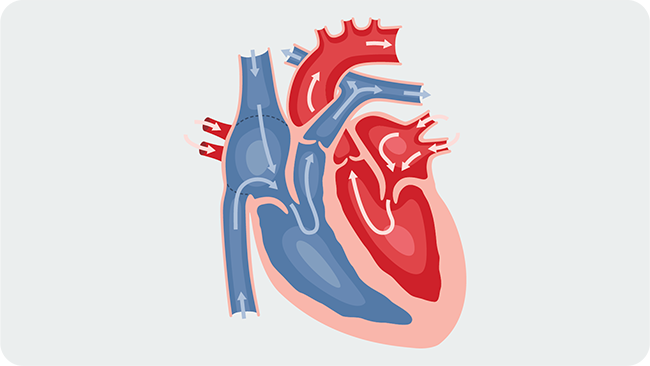HOW THE HEART WORKS
The heart is a pump that consists of four chambers separated by a wall and four valves. The two top chambers are called atria. They act like reservoirs. They collect and hold the blood until it can be moved to the main pumping chambers, the ventricles.
The contraction of the atria and of the ventricles, in a coordinated sequence, make your heart pump blood to supply oxygen to your body.
Your heart is normally slightly larger than your clenched fist. Your heart is capable of beating over 100,000 times a day (at a rate of about 70 beats per minute).
In one day it pumps more than 1,760 gallons (7,000 liters) of blood through approximately 11,800 miles (19,000 km) of circulatory system. The right atrium collects ‘used’ blood from all over your body. The right ventricle pumps the used blood to both lungs. The left atrium collects the newly oxygenated blood from your lungs. The left ventricle pumps the oxygen-rich blood back to feed the heart muscle itself and to the rest of your body.




WHAT IS TACHYCARDIA?
If your heart rate is over 100 beats per minute this is called tachycardia. There are normal and abnormal fast heart rhythms. Exercise, mental or emotional stress, and some illnesses can cause your heart rate to rise normally, above 100 beats per minute.
When your heart rate is too fast, however, or occurs without cause, or is too fast and irregular, it is called a tachyarrhythmia.
The different types of tachyarrhythmia include Ventricular Tachycardia (VT) and Ventricular Fibrillation (VF), and are described below.
Ventricular Tachycardia (VT)
VT is an abnormal rapid heart rate that originates in the ventricles. The heart pumps less blood with each beat because there isn’t enough time for the chambers to refill with blood between beats. This causes symptoms such as dizziness, lightheadedness, near fainting symptoms, fainting, and loss of consciousness. For most patients, VT is dangerous if not treated.
Ventricular Fibrillation (VF)
In VF, the heart beats very fast and irregularly. This is due to chaotic electrical activity of the ventricles.
Little or no blood is pumped. Your brain, heart and the rest of your body are quickly starved of oxygen. Patients usually pass out within a few seconds. VF almost never stops on its own, and is therefore fatal unless the normal rhythm is restored with an electric shock to ‘reset’ the heart (defibrillation). Defibrillation can be given by doctors or emergency medical personnel using paddles held to the chest (external defibrillation), or automatically by an implantable defibrillator (ICD or CRT-D).
VT and VF have a number of causes, the most common of which is scarring of the heart due to a previous heart attack. Cardiac enlargement as a result of heart failure is also an important cause.
An example of ventricular fibrillation
The electrical signal is not following the normal pathway. Instead, multiple electrical outbreaks are firing at the same time. The heart cannot contract properly, making the pump inefficient until a normal rhythm is restored.